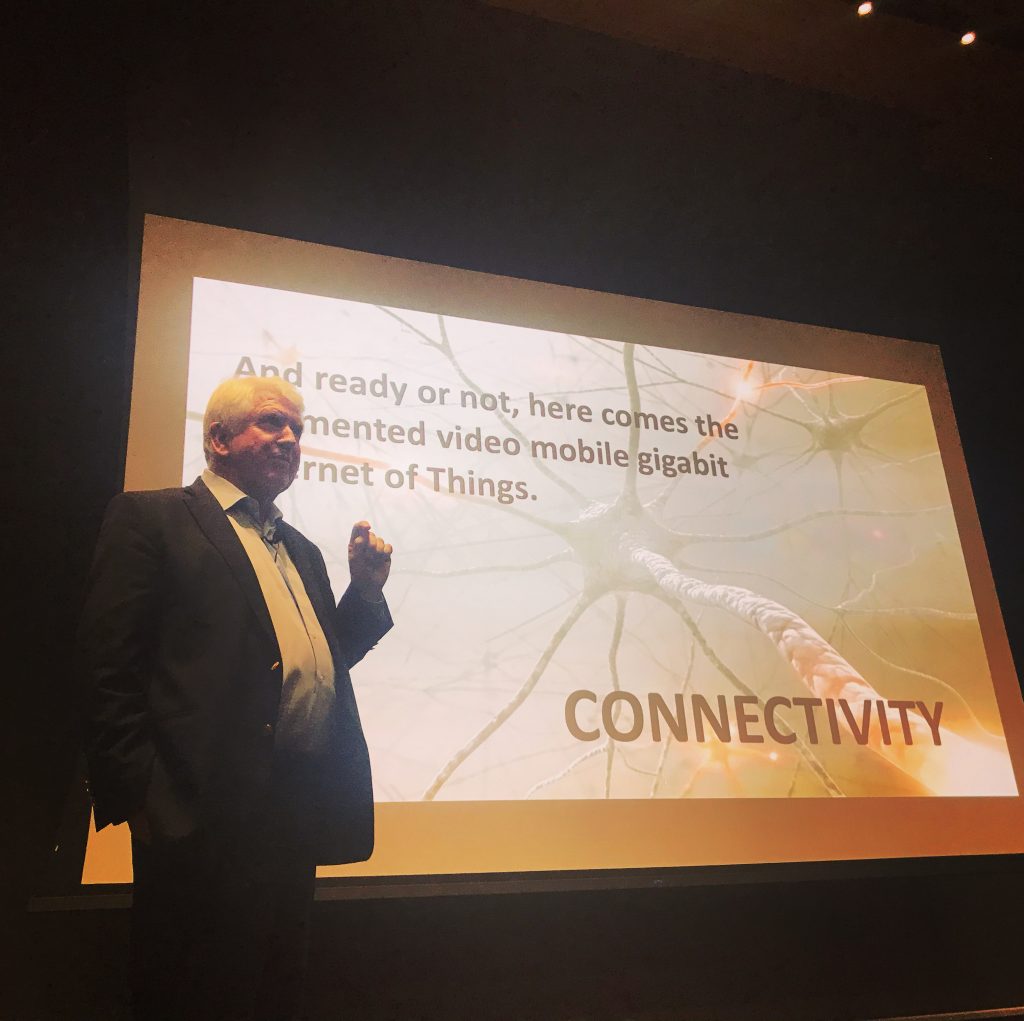
Connectivity is not new, said Bob Metcalfe, inventor of Ethernet and professor of innovation at the University of Texas at Austin.
It harkens back to rivers and roads. The Chinese expression is “If you want to get rich, first build a road,” he said.
His ancestor, Blind Jack Metcalf, built the first 180 miles of road out of Yorkshire, England, at the start of the Industrial Revolution.
Metcalfe, born in 1946, said he was lucky to be born at that time because so many inventions were happening including the wireless TV. But chief among them, in 1947, Bell Labs invented the transistor and that began the movement of connectivity from atoms to bits, he said.
“The roads to the Internet,” he said.
Metcalfe gave a talk Thursday afternoon reflecting on the 50th anniversary of the Internet in the Mulva Auditorium in the Engineering and Education Research Center at UT Austin.
The official birth date of the Internet is Oct. 29th, 1969, when a UCLA student, Charley Kline, sent the first online message to the Stanford Research Institute over a link on the ARPANET, the predecessor to the Internet. The routing computer for ARPANET was made by BBN, based in Cambridge, Massachusetts, and was created by a team headed up Frank Heart.
When Kline tried to send the message “Login” the system crashed after he typed Lo – so the first message was Lo. It was later spun into “Lo and behold the Internet.”
In 1969, Metcalfe was working on a four-person team on a senior project at the Massachusetts Institute of Technology to build a computer. He got the job of building the computer’s memory. When it came time to present the project, the other three students had dropped out of the class and Metcalfe had memory but no computer. He did get an A in the class. Most importantly, that project taught him how to send bits down a very long wire one at a time, he said.
At that time, the ARPANET had four connections or “nodes” which included UCLA, Stanford Research Institute, U.C. Santa Barbara, and the University of Utah.
Around that time, Metcalfe got a job at MIT to connect four of the university’s computers to the ARPANET. He created the “PDP-10 IMP Interface, MIT Project MAC, 1970” that ran for 13 years, he said.
During his presentation, Metcalfe showed a chart with all the early connections made to ARPANET. The first country, outside the United States, to connect was Norway.
Metcalfe joined the Xerox Palo Alto Research Center, known as Xerox PARC, in 1972.
The reason Ethernet got developed was Xerox PARC was building what arguably was to become the first personal computer, Metcalfe said. They needed someone to build a network to tie them all together, he said.
Metcalfe invented Ethernet with Dave Boggs, an electrical engineer, and researcher at PARC. The first Ethernet board in 1973 ran at 2.94 megabits per second, Metcalfe said.
“The speed of this network was determined by the space on this board,” he said.
Metcalfe showed a slide of his 1973 sketch of his original “Ethernet” vision.
Ethernet had to wait 25 years for Wireless Internet (WiFi) A lot of yellow (the official color of Ethernet) wires got strung in the meantime, Metcalfe said.
But the invention of Ethernet did not mean it automatically became a standard in the computing industry.
General Motors and IBM also approached the Institute of Electrical and Electronics Engineers with competing standards. The IEEE made all three standards: Ethernet was 802.3, General Motors’ Token Bus was 802.4 and 802.5 was IBM Token Ring. They battled it out in the marketplace and eventually Ethernet won as the standard, Metcalfe said.
In 1979, Metcalfe left Xerox PARC and founded 3Com. And in 1982, as a sales tool, he coined a phrase that has come to be known as Metcalfe’s Law that “the value of a telecommunications network is proportional to the square of the number of connected users of the system.” George Gilder in Forbes Magazine in 1995 and in his book “Telecosm” named it Metcalfe’s Law.
This year, as the Internet turns 50 years old, and the World Wide Web turns 30 years, already 4.49 billion people are connected online, up nine percent from 2018, Metcalfe said. That is already 57 percent of the 7.7 billion people on the planet, he said.
“This rush of connectivity is highly correlated with accelerating freedom and prosperity,” Metcalfe said.
It’s also led to web publishing and innovations in search with Google in 1998 and e-commerce with Amazon in 1994, followed by the rise of social networks with Facebook in 2004 and Twitter in 2006.
There has been a convergence of voice, video, data industries that led to giant industry disruptions, Metcalfe said. The next big disruptions will also be very big, and they will be in education, energy and health, he said.
The Internet has also created a lot of what Metcalfe calls “pathologies of sudden connectivity” that has led to the proliferation of online porn, spam, polarization, radicalization, addiction, erosion of privacy, breaches of security, hate speech, and the spread of fake news.
Metcalfe quit posting to Twitter when his Apple watch told him he was spending 3.5 hours a day on Twitter. He went cold turkey in January of this year and hasn’t tweeted since then he said.
And the pace of change is only accelerating. The first 50 years of the Internet is only just the beginning, Metcalfe said. More and greater disruptions are on the horizon.
The “augmented video mobile gigabit Internet of Things” is here and it is leading to even more connectivity, Metcalfe said. There are already eight billion things connected to the Internet, outnumbering the number of people on this planet.
“Connectivity is a new frontier,” Metcalfe said. “It’s open. It’s not closed.”
